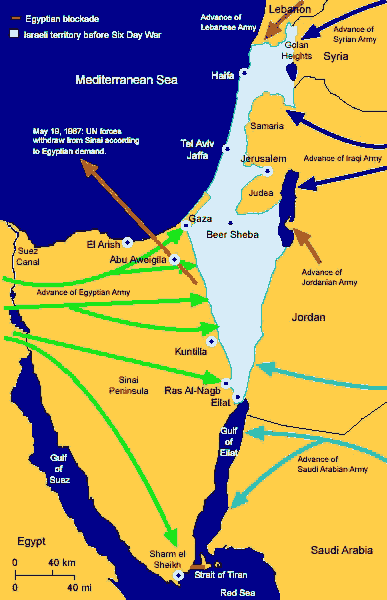Until 1967, Israel did not hold an inch of the Sinai Peninsula and the West Bank, the Gaza Strip or the Golan Heights. Israel held not an acre of what is now considered disputed territory. And yet we enjoyed no peace. Year after year Israel called for – pleaded for – a negotiated peace with the Arab governments. Their answer was a blank refusal and more war… The reason was not a conflict over territorial claims. The reason was, and remains, the fact that a free Jewish state sits on territory at all. – Prime minister Yitzhak Rabin, before a joint session of the US Congress, January 28, 1976
Those who have been paying attention know that France will convene a summit on 30 May of some 30+ countries and international organizations to discuss how they will move forward the two state solution, with a much broader effort toward the second part of the year. It is well know that these parameters will be based on the Arab Peace Initiative of 2002 as the basis for a two-state solution, at its core. That initiative is based on the 1967 lines with a shared capital in Jerusalem.
Most on both sides of the issue in the general public have no knowledge of the events at that time. It is important to understand how the 1967 war started, the causes and the mindset of those involved at the time. From a purely military perspective, to go back to the 1967 lines for Israel would be suicide, even with guarantees of peace by Arab nations. Yet this is exactly the position the US and the world is moving to, along with promises that they will let nothing happen to Israel. Ironically this is a similar position the US took with Israel leading up to the 1967 War.
The Americans on numerous occasions rebuffed Israeli diplomatic appeals, instead of using strongly worded #Hashtags like the current administration. President Johnson publicly condemned the blocking of Tiran (port of Eliat blockade by Egypt) as “illegal”. In reality it was an act of war and it only emboldened the Arabs in the lead up to the war.
With that lead up below is an excerpt from the fantastic site Six Day War.org. It will give the reader a much broader understanding of the conflict and why the 1967 lines we hear of so often in the news are absurd.
What was the Six-Day War? Who were the combatants and why did they fight? How did the war affect the region and how did the world react?
Using research and analysis gathered from respected experts in Middle East history, politics and other related fields, this Web site answers those questions; because to understand the literal and metaphorical map of the modern Middle East — the geographic positions held by the region’s armies and the negotiating positions held by its leaders — one must first understand the Six-Day War, and more importantly, its causes and consequences.
The major factor instigating conflict between Israel and its neighbors — whether in 1967, 2000 or any other time — has been the the Arab leadership’s rejection of the legitimate right of Jews to reconstitute their national home in the Middle East, and Israel’s attempt to cope with the security challenges caused by this rejectionism.
As far back as 1929, when Arab rioters attacked Jewish communities in Palestine and massacred their inhabitants, the civil and human rights of Jews had been under violent attack. In 1948 it became an existential issue, with six Arab armies attacking the newly independent Israel in an attempt to wipe the state off the map.
Again in 1967, in the run up to the Six-Day War, Israel’s existence seemed to hang in the balance. As the armies of Egypt, Syria and Jordan openly prepared for battle against Israel, and Arab leaders and the Arab “street” called for its destruction, Israel faced frightful choices. “We had already started thinking in terms of annihilation, both national and personal,” explained Lt. Yossi Peled, a Holocaust survivor who was at the time a lieutenant in the Israel army. Israel’s Defense Minister Moshe Dayan, realizing the immense military challenge that would be caused by an Arab attack, told his cabinet: “God help us through if they hit us first.” Chief of Staff Yitzkhak Rabin had a nervous breakdown, which for a short time kept him from his duties.
Israel’s hospitals prepared for mass casualties, not only from the advanced conventional weapons supplied by the Soviets to Egypt and Syria and by the West to Jordan, but also from chemical weapons, which Egypt was known to have used during its war in Yemen.
The tensions continued to mount while Israel’s Prime Minister Levy Eshkol insisted, even as more and more Arab troops massed on the borders, that diplomatic attempts to resolve the crisis be exhausted before Israel would consider military action.
This was the nature of the Arab-Israeli conflict before the Six-Day War, or in other words, before Israel ever occupied the West Bank and Gaza Strip.
Often, in current discussions about the Middle East, Israel’s occupation is mischaracterized as the primary, if not the sole, cause of the conflict rather than an effect of it. Many journalists, unfamiliar with the relevant facts and context, and mistakenly believing that the starting point of Mideast tensions is the “occupation,” may present flawed accounts that suggest the resolution of the tension can be achieved more or less simply by ending Israel’s presence in the territories. This ahistorical description is found all too often in the U.S. media, but even more pervasively in the European setting.

